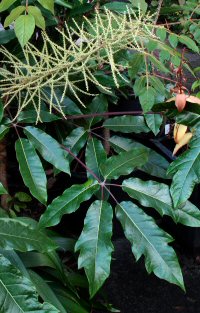 |
From a warmer climate and shared with us by Tony Avent is Schefflera delavayi a well known and much sought after tough species. I drool on seeing the tree by Dan Hinkley’s front door, it has to be 4m tall and covered in flowers this last autumn. It is a Chinese species that comes with a certain reputation, all good I'm pleased to say. Identification being just one complication, but thanks to Tony Avent's generosity in sharing his seed with us, we are at long last able to offer the true species, along with its reputation for growing at a snail's pace. A more positive trait is the hardiness, reputed to have sailed through countless cold winters. The juvenile foliage is its most appealing aspect to some, at a time when its 5-foliate leaves are deeply lobed, thick textured with a layer of wooly indumentum below. A long lived small tree in time attaining 8m in the wild, with a similar width. With terminal panicles of long slender spikes forming summer through winter
|